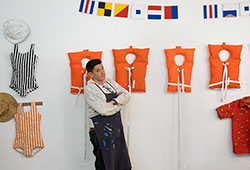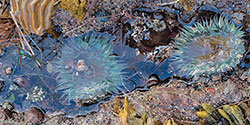July 14 - August 25, 2018
Reception: Saturday, July 14, 5-7PM
Artist Talk: Saturday, August 4, 11am
RSVP by Thursday, August 2
310-828-6410
info@craigkrullgallery.com
Phranc, or as she calls herself, “the All-American Jewish Lesbian Folksinger,” began her musical career in L.A. with punk groups like Nervous Gender in the early 80s. She quickly went solo, with an amazing career telling story-songs about women heroes like “Martina” (as in Navratilova), and “I Don’t Like Female Mudwrestling.”
In her other career is as a visual artist, she calls herself “The Cardboard Cobbler”, making everyday objects with paper and cardboard, thread and paint. Previous exhibitions at Craig Krull Gallery have focused on beachwear, winter/ski apparel, and vintage toys. At the museum shop of The Autry Museum of the American West, she created an entire
store within a store, based on old western trading posts. This project coincided with the Autry’s Out West program of LGBTQ histories of the West, organized by Gregory Hinton.
Phranc’s new exhibition at our gallery, entitled Swagger, will include colorful hand-made paper dresses that recall her youth when she was taken to her uncle’s dress shop downtown to try them on (which made her very uncomfortable). She says, “Butch fashion is my armor. The dresses I was forced to wear when I was young only made me more determined to dress the way I do today.” Also included are paper life jackets that refer to her Lesbian-Feminist heroes who are fiercely surviving and thriving. As Phranc says, these jackets are “strong enough to float me in a world that wants me to drown." At the opening reception on Sat., July 14, Phranc is orchestrating a “Butch Parade”, a fashion show in which these heroes sail down the runway, head above water in her paper life jackets.
For more than four decades, Connie Jenkins has used water as both a subject and a metaphor. She recognizes the ebb and flow of tides, like the seasons and other natural cycles, as fundamental connections to our natural environment. Her recent tide pool paintings bear a relationship to photo-realism, but, as Jenkins explains, in painting water, she has “tried to paint the visual patterns with which our brains construct images—a shared illusion.” The water is rippled and foamy, blurring and bending the shapes of the purple sea urchins and green anemone below. By focusing on a horizonless bird’s-eye view of the water, Jenkins flattens the image, making it both an illusionistic representation of water, and an abstraction of paint marks that acknowledge the canvas as an object. The tide pool’s surface becomes the picture plane where illusion meets abstraction.

